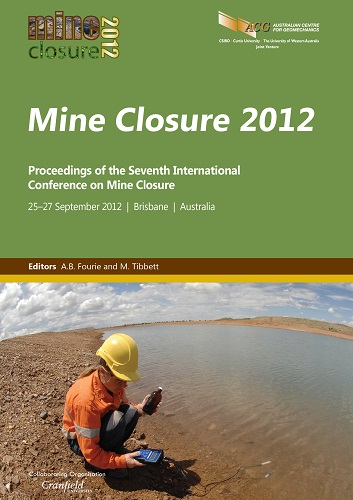Community greenways – ecological and recreational re-use of industrial landscapes

|
Authors: Backhouse, DC Paper is not available for download Contact Us |
DOI https://doi.org/10.36487/ACG_rep/1208_63_Backhouse
Cite As:
Backhouse, DC 2012, 'Community greenways – ecological and recreational re-use of industrial landscapes', in AB Fourie & M Tibbett (eds), Mine Closure 2012: Proceedings of the Seventh International Conference on Mine Closure, Australian Centre for Geomechanics, Perth, pp. 759-770, https://doi.org/10.36487/ACG_rep/1208_63_Backhouse
Abstract:
This paper focuses on the design and implementation of Community Greenways planning in British Columbia, and specifically on the benefits and opportunities for proactive community engagement in the development of recreational systems for mine sites and other working landscapes. The concepts of community greenways were established within a guideline document Community Greenways: Linking Communities to Country and People to Nature (Backhouse and Reid, 1995) published jointly by the Province of British Columbia and the federal Department of Fisheries and Oceans. Therein, community greenways are defined as ‘interconnected corridors linking human development and natural systems.’ A key component of the Community Greenway concept is the integration of mine sites and working landscapes that acknowledge the importance of resource extraction activities and incorporate these requirements within a comprehensive plan for sustained environmental and recreational networks. Since the publication of the Community Greenways Guide the authors have worked with local governments and industry to apply these concepts. The authors have consulted to local and regional governments to develop many strategic plans which set out land management and acquisition plans for park systems and trails covering many thousands of square kilometres and 100s of kilometres of walking, cycling and equestrian trails. This strategic planning work is reinforced by dozens of individual park plans and design implementation. All of this work has been undertaken within the context of significant public engagement including hundreds of community meetings and council presentations. It is apparent from this work that a significant strength of the Community Greenways concept continues to be its leveraging impact for individual sites within a well-developed and community supported system. A secondary benefit has been the opportunity to encourage communities and individuals to understand the lifecycle of mine sites and industrial facilities and to instil a longer term perspective that includes significant disruption over the short term with the understanding of long term imperatives for environmental and recreational networks are also accommodated. This paper will include a review of the basic concepts of the Community Greenways structure and from that starting point, the authors will provide a critical review of examples drawn from their experience in subsequent consulting project work including a variety of disused coal mines at Crofton, Chemainus, and Ladysmith, and others along the east coast of Vancouver Island. The paper will focus on the beneficial impacts of greenway system planning, and specifically on the beneficial impacts of community consultations in developing both a consensus solution and greater awareness of the requirements of mines and working landscapes. Finally the paper will provide a critical assessment of the strengths and weaknesses of the proposed approach and an assessment of opportunities and strategies for future implementation of these ideas.
References:
Backhouse, D. and Reid, D. (1995) Community Greenways: Linking Communities to Country and People to Nature, Ministry of Environment Lands and Parks, and Department of Fisheries and Oceans.
Backhouse, D. (2003) Cowichan Trails: Draft Trail Network and Cycling Plan, Prepared for the District of North Cowichan.
Backhouse, D. (2007) Regional Parks and Trails Master Plan, Prepared for the Cowichan Valley Regional District.
Fabos, J.G. and Ahern, J. (1996) Greenways: The Beginning of an International Movement, Elsevier Press.
Flink, C.A. and Searns, R.M. (1993) Greenways: A Guide to Planning, Design, and Development, The Conservation Fund, Island Press.
Flink, C.A. (2010) Greenways Incorporated, North Carolina, www.greenways.com.
Geiger, H. J., Pery, T., Fukuwaka, M. and Radchenko, V. (2002) Status of Salmon Stocks and Fisheries in the North Pacific Ocean, NPAFC Technical Report No. 4, Alaska Department of Fish and Game.
Quayle, M. and Hamilton, S. (1999) Corridors of Green and Gold: Impact of Riparian Suburban Greenways on Property Values, Prepared for: Fraser River Action Plan, Department of Fisheries and Oceans.
Smith, D.S. and Hellmund, P.C. (1993) Ecology of Greenways: Design and Function of Linear Conservation Areas, University of Minnesota Press.
© Copyright 2025, Australian Centre for Geomechanics (ACG), The University of Western Australia. All rights reserved.
View copyright/legal information
Please direct any queries or error reports to repository-acg@uwa.edu.au
View copyright/legal information
Please direct any queries or error reports to repository-acg@uwa.edu.au